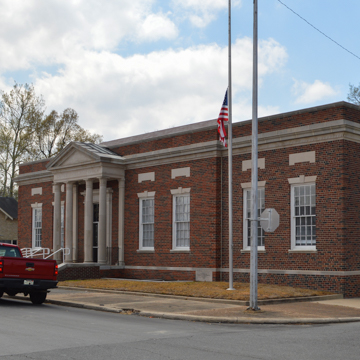Stuttgart’s City Hall occupies a building that was the town’s post office until the postal service moved to a new building in 2002. Constructed of red brick, the one-story Colonial Revival building has a classical portico of four limestone columns and a pediment outlined with dentils. Limestone is used for the sills, lintel, and keystones of the rectangular windows and for the swag decoration above them. The design suits the building’s adopted civic function well, giving a time-honored classical face to city business. The two-bay addition of 1966 matches the building in height and design.
You are here
Stuttgart City Hall (U.S. Post Office)
1931, James A. Wetmore, Supervising Architect of the U.S. Treasury; 1966 addition. 302 S. Maple St.
If SAH Archipedia has been useful to you, please consider supporting it.
SAH Archipedia tells the story of the United States through its buildings, landscapes, and cities. This freely available resource empowers the public with authoritative knowledge that deepens their understanding and appreciation of the built environment. But the Society of Architectural Historians, which created SAH Archipedia with University of Virginia Press, needs your support to maintain the high-caliber research, writing, photography, cartography, editing, design, and programming that make SAH Archipedia a trusted online resource available to all who value the history of place, heritage tourism, and learning.


